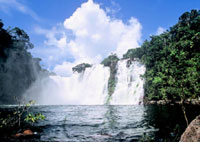
|
Adapting to Climate Variability and Change
  |
| At least 20 waterfalls tumble from the edges of the Huanchaca Plateau in Noel Kempff
Mercado National Park, Bolivia. The sandstone escarpment rises some 1,800 feet above the surrounding plain. |
We now know that our climate is changing: this is evident from increases in global average air and
ocean temperatures, melting of snow and ice, and rising sea levels. Adaptation refers to efforts to
cope with the impacts of current climate variability and future climate change. Rising temperatures,
changes in precipitation patterns, shifts in seasons, and rising seas are some of the expected
manifestations of climate change. Resulting impacts on water resources, coastal zones, agricultural
productivity, and the ranges of diseases could affect both human and ecological systems.
To learn more about Adapting to Climate Variability and Change, click here.
Related Links and Documents
- U.S. Government Activities
- USAID-supported Activities
- Relevant Work of Other Programs
Back to Top ^
|